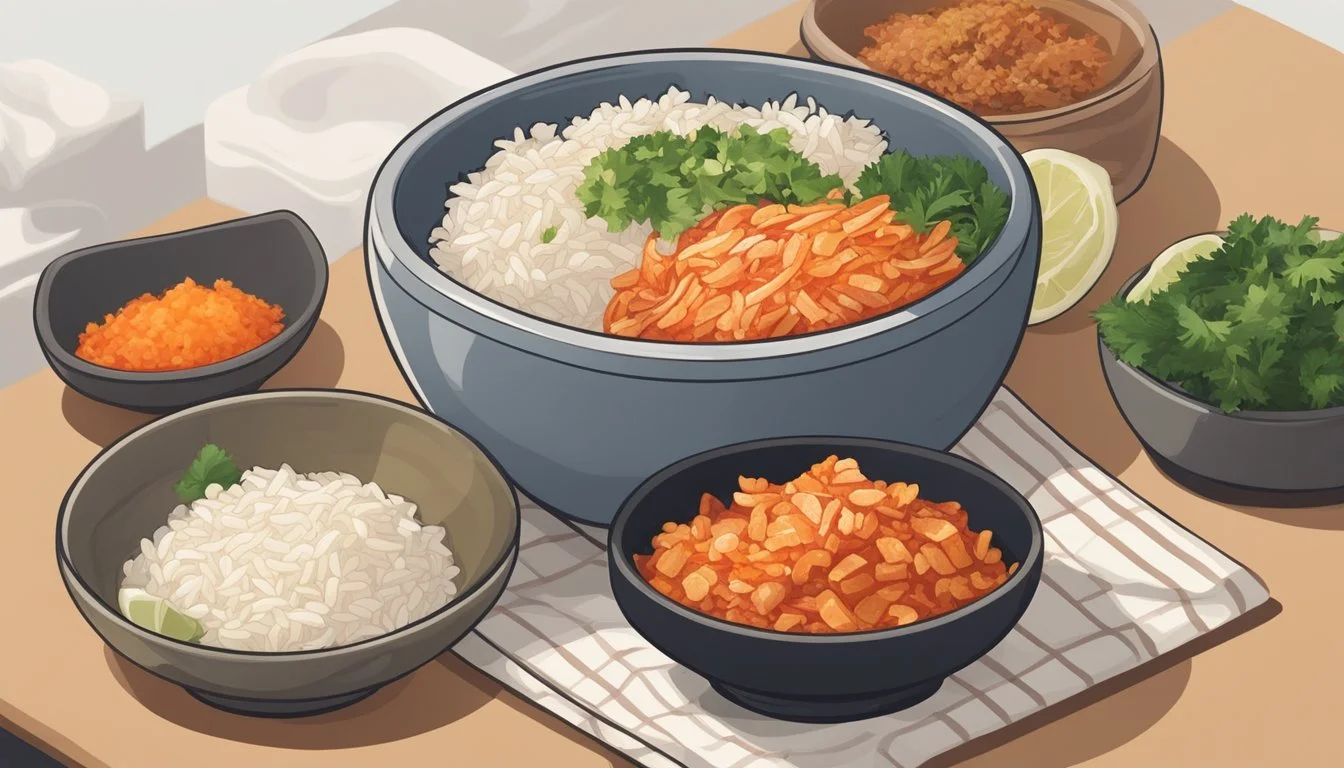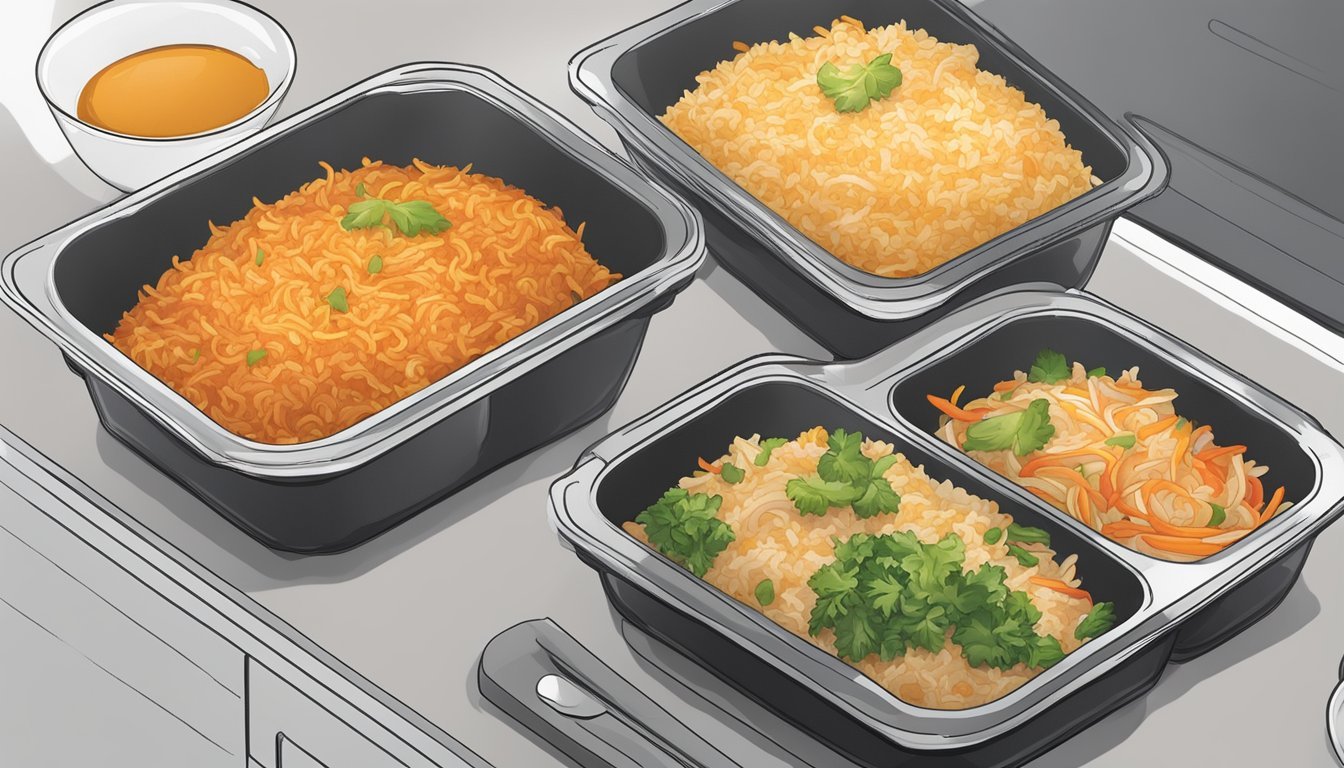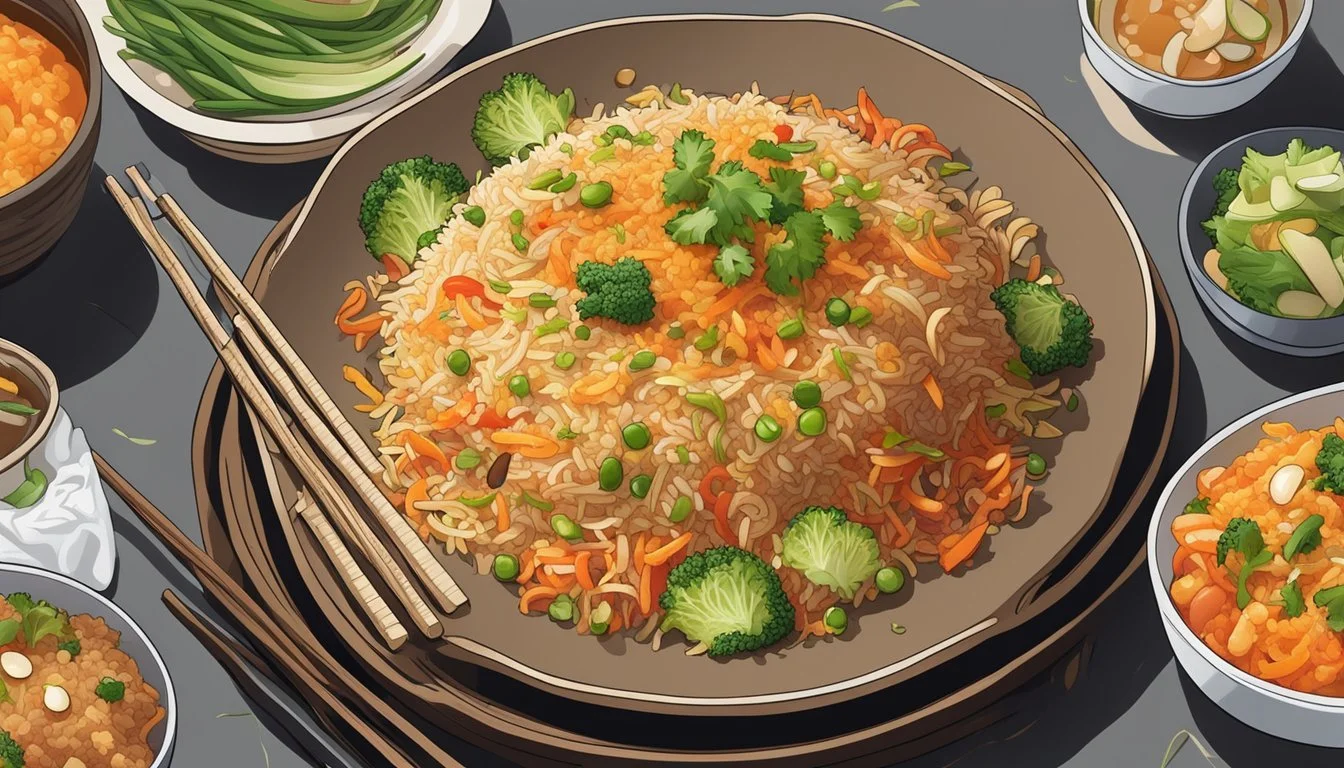How Do You Eat Kimchi Fried Rice?
Mastering the Art of Enjoying This Korean Dish
Kimchi fried rice, a staple in Korean cuisine, is a flavorful and satisfying dish enjoyed by many. Typically made with fermented kimchi, it carries a unique taste combined with the comfort of fried rice. It is versatile, allowing for various additions such as vegetables, meats, and seafood, making it both a complete meal on its own or a side to other dishes.
Eating kimchi fried rice is simple and straightforward. It is often served hot, straight from the frying pan, allowing the full spectrum of flavors to shine through. The rice absorbs the rich and spicy flavors of the kimchi, which is balanced with the savory notes of sesame oil and soy sauce.
The inclusion of ingredients like onions, scallions, and optional proteins such as pork or tofu contribute to the depth of the dish. Some enjoy topping it with a fried egg, adding a layer of richness to the overall meal. The adaptability of kimchi fried rice means that it can cater to a variety of taste preferences and dietary requirements, solidifying its position as a beloved food in and outside of Korea.
The Basics of Kimchi Fried Rice
Kimchi Fried Rice, or Kimchi Bokkeumbap, is a quintessential Korean dish known for its bold flavors. It's a stir-fried dish that combines kimchi (fermented vegetables, typically cabbage, with a distinctively spicy and sour taste) with day-old or leftover cooked rice (how long does cooked rice last?), creating a harmonious blend of spicy, savory, sour, and umami elements.
Ingredients:
Kimchi: The key component that provides the dish with its flavor.
Rice: Day-old or leftover cooked rice works best for a non-sticky and firm outcome.
Sesame Oil: Used for its nutty aroma and is a staple in Korean cooking.
Gochujang: A Korean red chili paste that imparts a sweet and spicy flavor.
Seasonings: A mixture of soy sauce, sugar, and other spices.
Preparation:
The rice should be pre-cooked and preferably chilled to ensure distinct grains that won't clump when fried.
Heat sesame oil in a pan, typically over medium-high heat to create a suitable cooking environment for fried rice.
Sauté diced garlic and any additional vegetables (e.g., carrots) to add layers of flavor.
Stir in kimchi and gochujang, frying until well-incorporated and kimchi achieves a soft texture.
Cooking Technique:
It is essential to stir frequently and maintain consistent heat to avoid burning while ensuring even distribution of seasonings.
Optionally, one can add proteins such as bacon or tofu to enhance the dish's savoriness.
A common practice is to create a well in the center of the pan, crack in eggs, and allow them to cook before mixing into the rice.
The completed dish is usually garnished with scallions or sesame seeds and can be served with additional side dishes or enjoyed on its own. With this recipe, one captures the essence of traditional Korean food, (What wine goes well with Korean food?) delivering a delight of textures and flavors.
Preparing the Ingredients
Creating an exemplary kimchi fried rice dish starts with the careful selection of ingredients, ensuring the rice has the perfect texture, the protein adds the necessary richness, and the vegetables and seasonings bring balance and flavor.
Rice Selection
For kimchi fried rice, the most suitable base is day-old rice because it has the ideal firmness and reduced moisture content that prevents clumping during frying. Opt for short grain, jasmine, or mixed grain rice; while brown rice adds a healthful twist.
Preferred Rice Types:
Day-old rice
Leftover rice
Short grain or jasmine
Brown or mixed grain rice
Proteins to Include
Proteins like egg, pork, chicken, or tofu can be integrated into kimchi fried rice to enrich the dish with flavor and texture. Consider adding eggs scrambled into the rice or as a topping, or ham, spam, or beef for additional savory notes.
Protein Options:
Egg (scrambled in or as a topping)
Pork cuts, diced ham or spam
Chicken breast or thighs, diced
Cubed tofu for a vegetarian option
Vegetable Additions
The vegetables most commonly paired with kimchi fried rice include green onions, napa cabbage, mushrooms, and carrots. Fermented vegetables like kimchi are essential, and enoki mushrooms or shredded seaweed (gim/nori) can be unique additions.
Vegetable Additions:
Green onions, sliced
Napa cabbage, chopped
Mushrooms (button or enoki), sliced
Carrots, julienned
Seaweed (gim/nori), shredded
Seasonings and Sauces
Balance the dish's flavor with gochujang (Korean chili paste), sesame oil, soy sauce, and kimchi juice. Adding garlic, ginger, and gochugaru (chili powder) can enhance the taste.
Seasonings and Sauces:
Gochujang (Korean chili paste)
Sesame oil
Soy sauce
Fresh garlic, minced
Ginger, grated
Gochugaru (Korean chili powder)
Optional Enhancements
To further elevate the dish, consider adding roasted or toasted sesame seeds for a nutty crunch, or strips of nori for a burst of umami. For extra heat, additional gochugaru or fresh chili can be sprinkled on top.
Optional Enhancements:
Roasted or toasted sesame seeds
Nori strips
Accompanying Side Dishes
Kimchi fried rice can be paired with a variety of side dishes such as kimchi jjigae (stew), kimchi pancake, or a light kimchi udon soup. A simple salad or a side of noodles can balance the hearty rice dish.
Side Dishes:
Kimchi jjigae (kimchi stew)
Kimchi pancake
Kimchi udon soup
Simple green salad
Noodles
Cooking Techniques
Kimchi fried rice, a staple Korean comfort food, combines the bold flavors of kimchi with the classic technique of stir-frying rice. It's easy to make and is popular for a quick weeknight dinner. The following subsections provide detailed methods to ensure a flavorful and satisfying meal.
Frying the Rice
For the best texture, chefs often use day-old rice because it has less moisture than fresh rice, preventing the dish from becoming soggy. They start by heating cooking oil in a pan over medium-high heat before adding the rice. Stirring continuously, the goal is to stir-fry the rice until it's slightly crispy, which takes about 3 to 5 minutes.
Adding Kimchi and Seasonings
Next, minced garlic is added to the pan, followed by chopped kimchi, allowing the tangy flavors to develop. The critical seasonings include gochujang (Korean red chili paste), soy sauce, and sometimes kimchi juice to enhance the dish's savoriness and depth. The mixture is fried for an additional 3 to 4 minutes until the kimchi softens and the spices are well integrated.
Finishing Touches
To round off the dish, a splash of sesame oil is drizzled in for a nutty aroma. It's often garnished with green onions, roasted or toasted sesame seeds, and sometimes strips of gim (seaweed). A fried egg with a runny yolk may be placed on top of the kimchi fried rice, adding a creamy texture that complements the dish's robust flavors. Variations might include different proteins or vegetables, tailored to individual preferences.
Serving Suggestions
Kimchi fried rice is a staple comfort dish that is both easy to make and adaptable for weeknight dinners. Presentation and pairing can elevate this simple dish into a more complete and satisfying meal.
Presentation Tips
When serving kimchi fried rice, presentation enhances the dining experience. One might opt to top the rice with a fried egg, allowing the runny yolk to add richness when mixed in. A generous sprinkle of chopped green onions and a garnish of seaweed strips can introduce both color and a subtle oceanic flavor. To add a touch of elegance, one can mold the rice into a round shape using a bowl before inverting it onto the plate, creating a dome-like appearance that is visually appealing.
Pairing with Other Dishes
Kimchi fried rice pairs well with various dishes to create a harmonious meal. As a side dish, consider serving a light salad to balance the hearty flavors with a fresh, crisp texture. Alternatively, complement the rice with a bowl of kimchi jjigae or another type of soup to add warmth and depth to the meal. For a protein boost, one might accompany the fried rice with grilled meats or tofu, marrying the flavors and textures.
Proper Storage and Reheating
Proper storage and reheating are vital to maintain the quality of kimchi fried rice leftovers. Ensuring appropriate temperature and methods can make a significant difference when one enjoys their meal later.
Refrigerating Leftovers
Leftovers should be placed in airtight containers and refrigerated within two hours of cooking to prevent spoilage. Leftover rice can harbor bacteria if left at room temperature for too long. To maximize freshness and safety, kimchi fried rice should be consumed within one to two days when stored in the refrigerator. For longer storage, freezing is an option, although it may alter the texture of the rice upon reheating.
Reheating Methods
Whether using a microwave or stovetop, even reheating is crucial for the best results. Here's how one can do it:
Microwave: Transfer the refrigerated kimchi fried rice to a microwave-safe dish, and cover with a suitable lid, leaving a small vent for steam to escape. Heat on high for about 2 minutes, stir, and then continue heating in 30-second bursts until hot throughout. The rice should reach an internal temperature of 165°F for safety.
Stovetop: For reheating on the stovetop, place the leftovers in a pan and add a splash of water or broth to prevent dryness. Cover and heat on a medium flame, stirring occasionally until the rice is heated thoroughly. If one prefers a slightly crisp texture, they can sauté the rice without a lid for the final few minutes.
Note: If the kimchi fried rice has been frozen, it's recommended to thaw in the refrigerator overnight before reheating to ensure even warming.
Health Benefits and Dietary Considerations
Kimchi fried rice, a popular Korean dish, is not only flavorful but also has various health benefits rooted in its core ingredients. It typically incorporates fermented vegetables like kimchi, which contain probiotics beneficial for digestive health. The fermentation process increases the bioavailability of nutrients, making kimchi a rich source of vitamins A, B, and C.
Vegetables such as carrots, spinach, or onions often accompany kimchi fried rice, enhancing the dish with fiber, vitamins, and minerals. These elements are crucial for maintaining a balanced diet. For those seeking a umami flavor without meat, options like tofu serve as an excellent protein substitute, making the dish suitable for vegetarians.
In terms of dietary considerations, kimchi fried rice may vary in caloric content and nutritional balance. Here's a succinct breakdown of its components:
Ingredient Benefit Kimchi Probiotics, Vitamins A, B, C Vegetables Fiber, Vitamins, Minerals Tofu (Optional) Plant-based Protein Nori (Optional) Iodine, Flavor Enhancement
While traditionally served with a sunny-side-up egg and often garnished with nori, a seaweed rich in iodine, each serving of kimchi fried rice must be assessed for its overall nutritional content. It's crucial for individuals to consider the balance of macronutrients—protein, carbs, and fats—to align with their dietary needs.
One should be aware of the sodium content in kimchi, as it can be high due to the pickling process involved in its creation. Those on sodium-restricted diets should consume this dish in moderation. With a mindful approach to the ingredients and portion sizes, kimchi fried rice can be a healthful addition to a diversified diet.
Cultural Significance of Korean Fried Rice
Kimchi Fried Rice, known in Korea as kimchi-bokkeum-bap, is not just a popular dish but a cultural emblem within Korean cuisine. This dish is steeped in the Korean tradition of not wasting food, demonstrating resourcefulness through its use of leftover rice and kimchi.
Kimchi, a fermented vegetable dish, mainly cabbage, seasoned with various spices and fermented seafood, serves as the heart of many Korean recipes. The incorporation of kimchi in fried rice showcases Korea's love for bold and complex flavors. Historically, kimchi was developed out of the necessity to preserve vegetables for the winter months, becoming a year-round staple in Korean homes.
Fried rice, which is a pan-Asian-inspired dish, is customized distinctly by Koreans. Korean fried rice incorporates ingredients like diced vegetables, sometimes meat or seafood, and a variety of seasonings, making it a versatile and filling dish that reflects the adaptability of Korean food.
The preparation of kimchi fried rice is more than just a culinary practice; it's a window into Korean culture that emphasizes balance, nutrition, and the art of fermentation. As an integral part of Korean family meals and restaurant menus, it symbolizes comfort and the ubiquity of kimchi in Korean diets. This simple yet profound dish represents the fusion of tradition and modern tastes, solidifying its role in Korean heritage while continuing to evolve with contemporary palates.
Tips for First-Timers
When one first attempts to make kimchi fried rice, they should note that this dish is recognized for its funky and tangy flavor profile, derived from the fermented kimchi which serves as its cornerstone ingredient. Beginners should brace themselves for a unique flavor experience that also harbors a salty punch, typical of the kimchi and other seasonings.
Here are some tips for those new to making kimchi fried rice:
Ingredient Preparation: Ensure all ingredients are prepared before starting as the cooking process is fast-paced.
Kimchi Quality: Use well-fermented kimchi for the best flavor balance; it provides that essential funky taste which defines the dish.
Rice Texture: Day-old rice, slightly dry, is ideal for achieving the characteristic texture without becoming soggy.
Flavor Balance: Be mindful of the saltiness of your kimchi and other seasonings to avoid overpowering the dish.
Heat Management: Cook on medium-high heat to caramelize the kimchi slightly and develop flavors without burning.
Variations:
Those looking for a twist can add different proteins such as bacon, tofu, or seafood.
Enoki mushrooms can enhance the dish with their subtle texture.
Add a fried egg on top for an extra layer of richness.
Simplicity: Remember, kimchi fried rice is easy to make. It's about combining simple ingredients to create a harmony of flavors. Confidence and practice will quickly turn beginners into seasoned creators of this beloved dish.
Advanced Variations and Experimental Flavors
Kimchi fried rice serves as a versatile canvas for culinary creativity, allowing chefs to incorporate a variety of flavors and ingredients that transcend traditional Korean cuisine.
International Fusions
In creating international fusions, chefs often integrate elements from Chinese fried rice, using techniques such as wok-frying to impart a "wok hei" (the breath of the wok) flavor profile to the dish. Asian-inspired ingredients like sesame oil, soy sauce, and chili paste expand the dish's flavor spectrum, while unconventional ingredients like chorizo or pancetta can impart a novel twist to the traditional recipe.
Table of International Fusion Ingredients
Asian: Sesame oil, Soy sauce, Chili paste
European: Chorizo, Pancetta
Example:
Spicy Chorizo Kimchi Fried Rice - infusing the rice with spicy Spanish sausage to deliver a smoky, piquant flavor.
Adventurous Additions
For those who favor heat, integrating sriracha or various chili pastes can raise the spice level and add depth. Incorporating a range of fermented vegetables including radish or cucumber creates new textures and tangy notes complementing the kimchi's complexity.
List of Adventurous Additions
Spices: Sriracha, Different chili pastes
Fermented Vegetables: Radish, Cucumber
Example:
Fermented Trio Kimchi Fried Rice - blending traditional kimchi with fermented radish and cucumber for a layered fermentative punch.
Answers to Common Questions
What is Kimchi Fried Rice?
Kimchi fried rice, also known as Kimchi Bokkeumbap, is a popular Korean dish made from leftover rice stir-fried with kimchi, which is a fermented vegetable, typically cabbage. It's known for its tangy, slightly sour, and funky flavor profile.
What kind of rice is best for Kimchi Fried Rice?
Leftover rice that has been refrigerated is ideal for kimchi fried rice. The firm texture helps resist becoming mushy during stir-frying.
How can you add proteins to Kimchi Fried Rice?
Frequently, eggs are the protein of choice. They can be scrambled into the rice or served on top as a fried egg. You could also add protein like chicken, beef, or tofu.
What are some common additions to Kimchi Fried Rice?
It's common to find green onions for a fresh, sharp contrast. Additional vegetables such as carrots or mushrooms may be included, and for extra heat, gochujang (Korean chili paste) is often stirred in.
Is Kimchi Fried Rice spicy?
The dish has a tangy, savory flavor that can be spicy, depending on the kimchi used. Extra heat can be added to taste with sauces like gochujang.
How do you serve Kimchi Fried Rice?
Here's a simple way to serve this dish:
Step 1: Plate the fried rice.
Step 2: Optionally, top with a fried egg.
Step 3: Garnish with chopped green onions.
Step 4: Serve hot, with additional chili paste on the side if desired.
The dish is versatile to be enjoyed on its own or as a side to other Korean dishes.
Summary and Final Thoughts
Kimchi fried rice is a hallmark dish in Korean cuisine, often revered for its comforting blend of flavors and textures. It begins with kimchi, the fermented vegetable core, typically involving cabbage with a tangy and sometimes sour profile, which has been a staple in Korean food traditions. When the rich qualities of kimchi meet the warm, starchiness of rice, the result is a dish that many turn to for both flavor and solace.
The beauty of kimchi fried rice lies in its variations; chefs and home cooks alike can tailor it to personal tastes or cultural nuances. A typical recipe includes garlic, sesame oil, and gochujang (red chili paste), providing a medley of spicy, sweet, and savory notes. Vegetables, proteins, or even a fried egg often accompany the dish, enhancing its complexity.
In preparing kimchi fried rice, key steps involve:
Sautéing vegetables and garlic to build a flavorful base.
Including well-fermented kimchi for a depth of flavor.
Stir-frying rice with kimchi juice to infuse the grains with the characteristic taste.
Optional additions such as meats or an egg to complete the dish.
Beyond the steps, chefs should allow the kimchi to turn soft and deepen in color, ensuring the rice fully absorbs its unique flavors. Whether sharing with family or enjoying as a weekday meal, kimchi fried rice remains a cherished element in the vast repertoire of Korean cuisine, offering a reliable and delightful eating experience.






